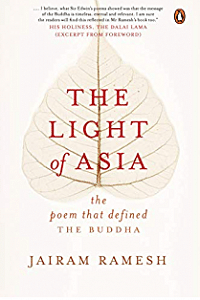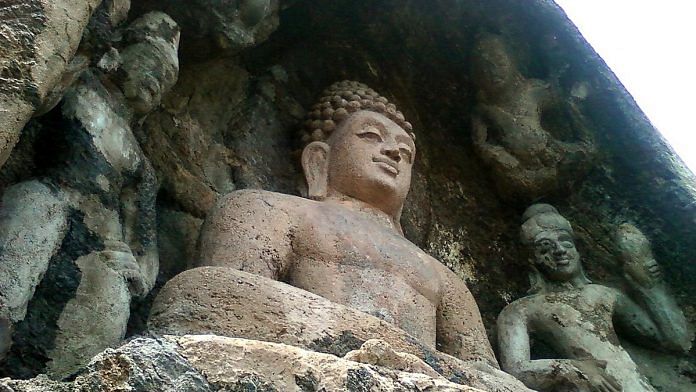On its release, the epic poem ‘The Light of Asia’, first published in 1879, immediately took England by storm, and soon thereafter America and Europe too were stirred by it. The epidemic of exuberance for it would spread to other parts of the world and last a few decades.
The book captivated an Indian monk who remains an iconic personality—Swami Vivekananda. At about the same time, it deeply moved a young man in Colombo who has become famous in history as Anagarika Dharmapala. It caught the attention of an aspiring Indian lawyer in London in 1889. This man later became immortal as Mahatma Gandhi. A few years hence it impacted a teenager in Allahabad who would, in 1947, become the first Prime Minister of India—Jawaharlal Nehru. Two copies of the book adorned the bookshelves of B.R. Ambedkar, the prime architect of the Indian constitution. It informed the work of men who were active in the movement for social justice, especially in south India in the early part of the twentieth century.
The book had a marked influence on at least eleven literary personalities from across the world. Five of them were Nobel Laureates: Rudyard Kipling in 1907, Rabindranath Tagore in 1913, W.B. Yeats in 1923, Ivan Bunin in 1933 and T.S. Eliot in 1948. The other six are legendary figures: Herman Melville, Leo Tolstoy, Lafcadio Hearn, D.H. Lawrence, John Masefield and Jose Luis Borges. It opened new frontiers for Joseph Campbell later to become one of the world’s leading authorities on comparative mythology.
The world of science and industry was not immune to its reach either. At the turn of the nineteenth century, it shaped the life of a young science student in Madras who would, in 1930, become India’s first Nobel Laureate in Physics—C.V. Raman. The Russian chemist and inventor of the periodic table Dmitri Mendeleev and the Scottish-American industrialist- philanthropist Andrew Carnegie had a special affinity to it. An extremely controversial figure of the British military but a hero during his time—Herbert Kitchener—would carry this book along with him wherever he went. It figures prominently in the private library of Alfred Nobel, the Swedish businessman who later endowed the Nobel Prizes.
In 1925, it was to serve as the basis for one of India’s first silent films, made by a German-Indian team. This was released internationally to some acclaim. In 1945 it figured in a Hollywood classic, The Picture of Dorian Gray. In 1957, a very ill Raymond Chandler, the British-American detective storywriter, received a letter from his long-time secretary advising him to take solace in reading this book.
Also read: Stone image of Durga, Nataraja idol & more — 36 antiques ASI recovered from UK, US, Australia
The book was translated into thirteen European, eight North and South East Asian and fourteen South Asian languages. A number of plays, dance dramas and operas were adapted from it in different countries. In the last fifty years, it has continued to evoke academic interest and has become the subject of doctoral dissertations and scholarly publications in the UK, Canada, USA and Germany. The most recent of these came out in February 2020 and dealt with its influence on James Joyce.
The book is The Light of Asia, a narrative of the life and message of the Buddha. Sir Edwin Arnold is its author. Its publication was a milestone in the nineteenth-century rediscovery of the Buddha. It occupies an important place in the historiography of modern Buddhism. I set out to understand how and why the book came to be written, and how and why its influence grew in country after country but more particularly in the sub-continent which gave rise to the Buddha over two and half millennia ago.
I first read The Light of Asia in my mid-teens. It has remained with me for over half a century. Two recent events rekindled my memories of the poem and its author.
First, while going through the correspondence of Jawaharlal Nehru, I discovered a letter to him dated 21 February 1955 from his British counterpart. Winston Churchill wrote:
I hope you will think of the phrase ‘The Light of Asia’. It seems to me that you might be able to do what no other human being could in giving India the lead, at least in the realm of thought, throughout Asia, with the freedom and dignity of the individual as the ideal rather than the Communist Party drill book.
Churchill was writing to a man imprisoned by the British in nine different spells between 1921 and 1945 for a total of almost ten years. The longest period Nehru spent in jail was between August 1942 and June 1945 when Churchill was prime minister. That is what makes this letter quite remarkable. But this was not all. Four months later, on 30 June 1955, Churchill again to wrote to Nehru:
I hope you will forgive the lapse of time in replying to your letter of April 8. Events following upon my resignation, and the General Election here, have delayed my correspondence greatly.
I was much touched by what you said. One of the most agreeable memories of my last years in office is our association. At our conferences [of Commonwealth Premiers] your contribution was a leading and constructive one, and I always admired your ardent wish for peace and the absence of bitterness in your consideration of the antagonisms that had in the past divided us. Yours is indeed a heavy burden and responsibility, shaping the destiny of your many millions of countrymen and playing your outstanding part in world affairs. I wish you well in your task. Remember ‘The Light of Asia!’
Only two bibliophilic prime ministers could have had a correspondence in the last decade of their lives recalling a book both had read when they were young. In fact, when Nehru was undergoing the second round of his imprisonment by the British in Lucknow jail, he wrote to his father on 13 July 1922:
I have received your kind letter . . . You need not worry at all about my health. I am looking after it carefully . . . I have received the books sent by you. I have now got the following:
- Memoirs of Babar
- Sarkar’s Shivaji
- Bernier’s Travels
- Vincent Smith’s Akbar
- Manucci’s Storia do Mogor—4 vols
- Bryce’s Holy Roman Empire
- Poems of Keats
- Poems of Shelley
- Tennyson’s Idylls of the King
- Arnold’s Light of Asia
- Havell’s Aryan Rule in India (this came separately)
- Pater’s Renaissance (received yesterday)
I had asked for many other books which are in Anand Bhavan [the Nehru family residence in Allahabad] . . .
And when his daughter was convalescing from pleurisy in Leysin in Switzerland, Nehru would on 22 February 1940 send ‘Arnold’s two little books: The Light of Asia and The Song Celestial’ to keep her company.
 This excerpt from ‘The Light of Asia: The Poem that Defined The Buddha’ by Jairam Ramesh has been published with permission from Penguin Random House India.
This excerpt from ‘The Light of Asia: The Poem that Defined The Buddha’ by Jairam Ramesh has been published with permission from Penguin Random House India.



